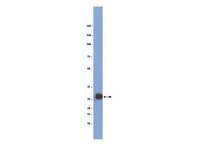Oligodendroglial maturation is dependent on intracellular protein shuttling.
Göttle, P; Sabo, JK; Heinen, A; Venables, G; Torres, K; Tzekova, N; Parras, CM; Kremer, D; Hartung, HP; Cate, HS; Küry, P
The Journal of neuroscience : the official journal of the Society for Neuroscience
35
906-19
2015
Show Abstract
Multiple sclerosis is an autoimmune disease of the CNS resulting in degeneration of myelin sheaths and loss of oligodendrocytes, which means that protection and electrical insulation of axons and rapid signal propagation are impaired, leading to axonal damage and permanent disabilities. Partial replacement of lost oligodendrocytes and remyelination can occur as a result of activation and recruitment of resident oligodendroglial precursor cells. However, the overall remyelination capacity remains inefficient because precursor cells often fail to generate new oligodendrocytes. Increasing evidence points to the existence of several molecular inhibitors that act on these cells and interfere with their cellular maturation. The p57kip2 gene encodes one such potent inhibitor of oligodendroglial differentiation and this study sheds light on the underlying mode of action. We found that subcellular distribution of the p57kip2 protein changed during differentiation of rat, mouse, and human oligodendroglial cells both in vivo and in vitro. Nuclear export of p57kip2 was correlated with promoted myelin expression, higher morphological phenotypes, and enhanced myelination in vitro. In contrast, nuclear accumulation of p57kip2 resulted in blocked oligodendroglial differentiation. Experimental evidence suggests that the inhibitory role of p57kip2 depends on specific interactions with binding proteins such as LIMK-1, CDK2, Mash1, and Hes5 either by controlling their site of action or their activity. Because functional restoration in demyelinating diseases critically depends on the successful generation of oligodendroglial cells, a therapeutic need that is currently unmet, the regulatory mechanism described here might be of particular interest for identifying suitable drug targets and devising novel therapeutic approaches. | 25609610
 |
Fingolimod attenuates splenocyte-induced demyelination in cerebellar slice cultures.
Pritchard, AJ; Mir, AK; Dev, KK
PloS one
9
e99444
2014
Show Abstract
The family of sphingosine-1-phosphate receptors (S1PRs) is G-protein-coupled, comprised of subtypes S1PR1-S1PR5 and activated by the endogenous ligand S1P. The phosphorylated version of Fingolimod (pFTY720), an oral therapy for multiple sclerosis (MS), induces S1PR1 internalisation in T cells, subsequent insensitivity to S1P gradients and sequestering of these cells within lymphoid organs, thus limiting immune response. S1PRs are also expressed in neuronal and glial cells where pFTY720 is suggested to directly protect against lysolecithin-induced deficits in myelination state in organotypic cerebellar slices. Of note, the effect of pFTY720 on immune cells already migrated into the CNS, prior to treatment, has not been well established. We have previously found that organotypic slice cultures do contain immune cells, which, in principle, could also be regulated by pFTY720 to maintain levels of myelin. Here, a mouse organotypic cerebellar slice and splenocyte co-culture model was thus used to investigate the effects of pFTY720 on splenocyte-induced demyelination. Spleen cells isolated from myelin oligodendrocyte glycoprotein immunised mice (MOG-splenocytes) or from 2D2 transgenic mice (2D2-splenocytes) both induced demyelination when co-cultured with mouse organotypic cerebellar slices, to a similar extent as lysolecithin. As expected, in vivo treatment of MOG-immunised mice with FTY720 inhibited demyelination induced by MOG-splenocytes. Importantly, in vitro treatment of MOG- and 2D2-splenocytes with pFTY720 also attenuated demyelination caused by these cells. In addition, while in vitro treatment of 2D2-splenocytes with pFTY720 did not alter cell phenotype, pFTY720 inhibited the release of the pro-inflammatory cytokines such as interferon gamma (IFNγ) and interleukin 6 (IL6) from these cells. This work suggests that treatment of splenocytes by pFTY720 attenuates demyelination and reduces pro-inflammatory cytokine release, which likely contributes to enhanced myelination state induced by pFTY720 in organotypic cerebellar slices. | 24911000
 |
M2 microglia and macrophages drive oligodendrocyte differentiation during CNS remyelination.
Miron, VE; Boyd, A; Zhao, JW; Yuen, TJ; Ruckh, JM; Shadrach, JL; van Wijngaarden, P; Wagers, AJ; Williams, A; Franklin, RJ; ffrench-Constant, C
Nature neuroscience
16
1211-8
2013
Show Abstract
The lack of therapies for progressive multiple sclerosis highlights the need to understand the regenerative process of remyelination that can follow CNS demyelination. This involves an innate immune response consisting of microglia and macrophages, which can be polarized to distinct functional phenotypes: pro-inflammatory (M1) and anti-inflammatory or immunoregulatory (M2). We found that a switch from an M1- to an M2-dominant response occurred in microglia and peripherally derived macrophages as remyelination started. Oligodendrocyte differentiation was enhanced in vitro with M2 cell conditioned media and impaired in vivo following intra-lesional M2 cell depletion. M2 cell densities were increased in lesions of aged mice in which remyelination was enhanced by parabiotic coupling to a younger mouse and in multiple sclerosis lesions that normally show remyelination. Blocking M2 cell-derived activin-A inhibited oligodendrocyte differentiation during remyelination in cerebellar slice cultures. Thus, our results indicate that M2 cell polarization is essential for efficient remyelination and identify activin-A as a therapeutic target for CNS regeneration. | 23872599
 |
Transcription factor-mediated reprogramming of fibroblasts to expandable, myelinogenic oligodendrocyte progenitor cells.
Najm, FJ; Lager, AM; Zaremba, A; Wyatt, K; Caprariello, AV; Factor, DC; Karl, RT; Maeda, T; Miller, RH; Tesar, PJ
Nature biotechnology
31
426-33
2013
Show Abstract
Cell-based therapies for myelin disorders, such as multiple sclerosis and leukodystrophies, require technologies to generate functional oligodendrocyte progenitor cells. Here we describe direct conversion of mouse embryonic and lung fibroblasts to induced oligodendrocyte progenitor cells (iOPCs) using sets of either eight or three defined transcription factors. iOPCs exhibit a bipolar morphology and global gene expression profile consistent with bona fide OPCs. They can be expanded in vitro for at least five passages while retaining the ability to differentiate into multiprocessed oligodendrocytes. When transplanted to hypomyelinated mice, iOPCs are capable of ensheathing host axons and generating compact myelin. Lineage conversion of somatic cells to expandable iOPCs provides a strategy to study the molecular control of oligodendrocyte lineage identity and may facilitate neurological disease modeling and autologous remyelinating therapies. | 23584611
 |












